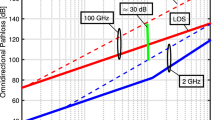Abstract
Spatial channel models are often proposed for modeling the angular aspects of mobile radio channel in picocell, microcell, and macrocellular environments. These models are validated through comparison with available measurement results. The comparisons are usually based on the fitness of their pdfs of angle of arrival to the histogram of occurrences of the signals over an angular span, given in the measurement data. This paper presents a comparison of the notable scattering models with various spatial channel measurements. The paper suggests criteria for the comparative analysis of the previously proposed spatial channel models and measurements on the basis of their fading statistics. Quantitative analysis of the considered models and the field measurements is also presented using multipath shape factors i.e. angle spread, the angular constriction and direction of maximum fading. Based on the obtained shape factors, fading statistics like level crossing rates, average fade duration, auto-covariance and coherence distance are evaluated. Effect of increasing Doppler spread on the level crossing rates and average fade duration is also elaborated in detail.












Similar content being viewed by others
References
Jakes WC (1994) Microwave mobile communications. IEEE Press, Piscataway
Ertel RB, Reed JH (1999) Angle and time of arrival statistics for circular and elliptical scattering models. IEEE J Sel Areas Commun 17(11):1829–1840
Petrus P, Reed JH (2002) Geometrical-based statistical macrocell channel model for mobile environments. IEEE Trans Commun 50(3):495–502
Khan NM, Simsim MT, Rapajic PB (2008) A generalized model for the spatial characteristics of the cellular mobile channel. IEEE Trans Veh Technol 57(1):22
Janaswamy R (2002) Angle and time of arrival statistics for the Gaussian scatter density model. IEEE Trans Wirel Commun 1(3):488–497
Khan NM (2006) Modeling and characterization of multipath fading channels in cellular mobile communication system. PhD thesis dissertation, School of Electrical Engineering and Telecommunication, University of New South Wales (UNSW), Australia, March 2006
Pedersen KI, Mogensen PE, Fleury BH (2000) A stochastic model of the temporal and azimuthal dispersion seen at the base station in outdoor propagation environment. IEEE Trans Veh Technol 49(2):437–447
Spencer QH, Jeffs BD, Jensen MA, Swindlehurst AL (2000) Modeling the statistical time and angle of arrival characteristics of an indoor multipath channel. IEEE J Sel Areas Commun 18(3):347–360
Cramer RJ-M, Win MZ, Scholtz RA (1998) Impulse radio multipath characteristics and diversity reception. IEEE Conf Commun 3:1650–1654
Jalden N, Zetterberg P, Ottersten B, Garcia L (2007) Inter- and intrasite correlations of large-scale parameters from microcellular measurements at 1800 MHz. EURASIP J Wirel Commun Netw
Zhang Y, Brown AK, Malik WQ, Edwardes DJ (2008) High resolution 3-D angle of arrival determination for indoor UWB multipath propagation. IEEE Trans Wirel Commun 7(8):3047–3055
Nawaz SJ, Qureshi BH, Khan NM (2010) A generalized 3-D scattering model for macrocell environment with directional antenna at BS. IEEE Trans Veh Technol 59(7):3193–3204
Durgin GD, Rappaport TS (2000) Theory of multipath shape factors for small-scale fading wireless channels. IEEE Trans Antennas Propag 48(5):682–693
Durgin GD, Rappaport TS (1998) Basic relationship between multipath angular spread and narrow band fading in wireless channels. IEE Electron Lett 24(25):2431–2432
Rappaport TS (2002) Wireless communications, principles and practice, 2nd edn. Prentice Hall, Upper Saddle River
Author information
Authors and Affiliations
Corresponding author
Rights and permissions
About this article
Cite this article
Loni, Z.M., Khan, N.M. Analysis of fading statistics in cellular mobile communication systems. J Supercomput 64, 295–309 (2013). https://doi.org/10.1007/s11227-012-0799-1
Published:
Issue Date:
DOI: https://doi.org/10.1007/s11227-012-0799-1




